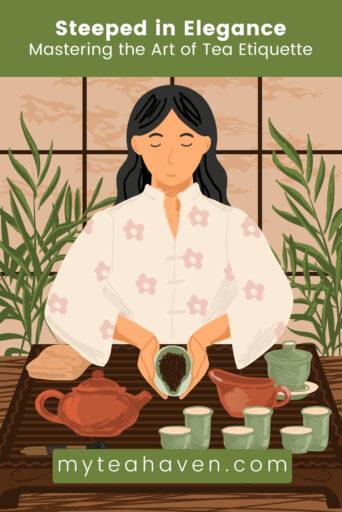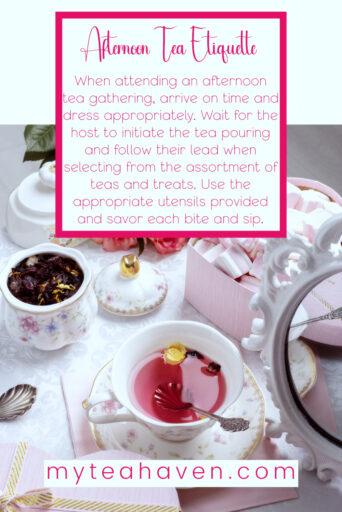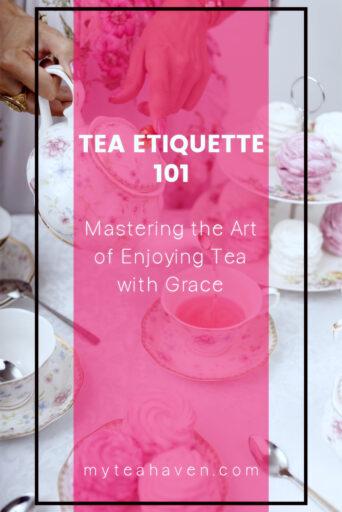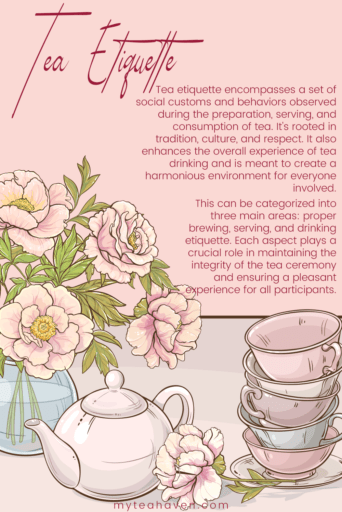Steeped in Elegance: Mastering the Art of Tea Etiquette
Tea Etiquette
Tea is a special beverage. Not only because it has a soothing aroma and delightful taste, but also because of the fascinating world of tea etiquette. Throughout the years, I have explored the art of tea drinking and the customs that surround it. Today I will guide you through the intricacies of general tea etiquette, providing helpful information to avoid any faux pas as you sip away at this wonderful drink.
We are a participant in the Amazon Services LLC Associates Program, an affiliate advertising program designed to provide a means for us to earn fees by linking to Amazon.com and related sites. This post may contain affiliate links which means we may receive a commission, at no cost to you, for purchases made using our links. Please see my disclosure to learn more. Unless otherwise stated, all prices are in US$.

Tea & Etiquette
Taking Tea for Business and Pleasure
Afternoon tea conjures up both feelings of elegance and gentility. It is, after all, synonymous with civility and blessed with the endearing quality of being part of the world’s enduring cup of humanity. This book includes tea history, tea and health information, steeping guides, as well as elements of both social and business tea etiquette. The authors have given you all the information needed to either serve or be served at a host of tea occasions.
Understanding Tea Etiquette
Before we learn more about tea etiquette, we first need to understand its significance.
Tea etiquette encompasses a set of social customs and behaviors observed during the preparation, serving, and consumption of tea. It’s rooted in tradition, culture, and respect. It also enhances the overall experience of tea drinking and is meant to create a harmonious environment for everyone involved.
Types of Etiquette
This can be categorized into three main areas: proper brewing, serving, and drinking etiquette. Each aspect plays a crucial role in maintaining the integrity of the tea ceremony and ensuring a pleasant experience for all participants.
Proper Tea Brewing
The first step begins with the proper brewing of tea. It involves selecting the right tea leaves, using the appropriate water temperature, and steeping the tea for the right amount of time.
The quality of water, teaware, and the art of pouring all contribute to the overall taste and aroma of the tea.
Tea Serving Etiquette
When it comes to serving tea, there are several etiquettes to follow. The host should handle the teapot with care and pour the tea gently into the cups, ensuring equal portions for all guests. The cups should be held by the handle or on the saucer, and the host should serve others before pouring their own cup.
Tea Drinking Etiquette
Drinking tea with grace and respect is an essential part of etiquette. Hold the cup by the handle or the sides and avoid touching the rim with your lips. Take small sips and don’t slurp! Engage in pleasant conversation and avoid disruptive noises that could disturb the tranquility of the tea ceremony.
Afternoon Tea Etiquette
Afternoon tea is a cherished tradition in many cultures, and it has its own set of rules.

When attending an afternoon tea gathering, arrive on time and dress appropriately. Wait for the host to initiate the tea pouring and follow their lead when selecting from the assortment of teas and treats. Use the appropriate utensils provided and savor each bite and sip.
High Tea Etiquette
Contrary to popular belief, high tea is not an elegant affair but a hearty meal enjoyed later in the day. It originated as a working-class tea, accompanied by substantial dishes.
When partaking in high tea, embrace the casual atmosphere and enjoy the heartier fare without the constraints of formal tea etiquette. It is an opportunity to indulge in comfort and conviviality.
Etiquette Around the World
Tea etiquette varies across different cultures, adding to the charm and diversity of tea ceremonies worldwide.
In Japan, the tea ceremony is steeped in mindfulness and simplicity.
In China, tea ceremonies emphasize the appreciation of tea and the art of steeping it.
Understanding these cultural nuances can deepen your appreciation for this magical beverage and its rituals.

Mistakes to Avoid
While drinking tea can be a fascinating journey, it’s essential to be aware of common mistakes to avoid any unintentional faux pas.
Some common blunders include stirring the tea vigorously, dunking the teabag repeatedly, or leaving the spoon in the cup while drinking. Another mistake you might make is lifting your pinky finger while sipping. Despite what you may have seen on TV, it’s actually considered to be rude!
These actions may disrupt the delicate flavors of the brew and violate proper etiquette.
A Few Final Thoughts
Tea etiquette is a beautiful blend of tradition, grace, and respect. By embracing and practicing these practices, we not only enhance our own tea-drinking experience but also honor the rich heritage associated with this beloved beverage.
So, the next time you prepare a cuppa or attend a tea gathering, remember the art of etiquette and savor every moment.

The Art and Proper Etiquette of Afternoon Tea
The Art and Proper Etiquette of Afternoon Tea, was written out of love for tea. It is dedicated to tea connoisseurs who love going out for Afternoon Tea in beautiful teahouses and dining on delicious scones, savories, petits fours, and of course, sipping their favorite brew of tea. In The Art and Proper Etiquette of Afternoon Tea, explore the world of tea etiquette along with carefully selected recipes that will become a cherished part of your repertoire.
Some Questions You Might Have
- Why is tea etiquette important?
It’s important as it adds elegance, respect, and tradition to the act of tea drinking. It enhances the overall experience, promotes social harmony, and pays homage to the cultural significance of tea ceremonies.
- Can I use any teaware for tea ceremonies?
It is best to use teaware specifically designed for tea ceremonies. Traditional teapots, teacups, and utensils are crafted to enhance the flavors and aesthetics of tea. However, if you don’t have specialized teaware, you can still enjoy tea while following basic guidelines.
- Is it necessary to attend tea ceremonies to appreciate tea etiquette?
Attending these ceremonies can provide a deeper understanding and appreciation for tea etiquette. That being said, even in everyday experiences, incorporating some best practices, such as brewing it correctly and drinking with mindfulness, can elevate the experience.
- Can I add milk or sugar when following proper etiquette?
It varies depending on the tea type and cultural practices. In some cases, adding milk or sugar may be acceptable, while in others, it may be frowned upon. It’s best to consider the specific tea and cultural context before altering the traditional preparation and serving methods.
- How can I learn more about tea etiquette?
To further explore this fascinating topic, you can delve into books, online resources, or even attend workshops or classes on tea ceremonies. Additionally, engaging in conversations with enthusiasts and experienced practitioners can provide valuable insights and guidance on etiquette.








